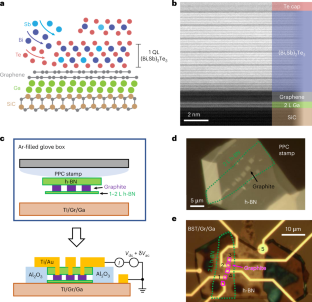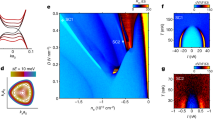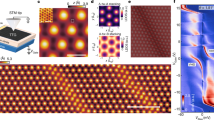Abstract
The introduction of superconductivity to the Dirac surface states of a topological insulator leads to a topological superconductor, which may support topological quantum computing through Majorana zero modes1,2. The development of a scalable material platform is key to the realization of topological quantum computing3,4. Here we report on the growth and properties of high-quality (Bi,Sb)2Te3/graphene/gallium heterostructures. Our synthetic approach enables atomically sharp layers at both hetero-interfaces, which in turn promotes proximity-induced superconductivity that originates in the gallium film. A lithography-free, van der Waals tunnel junction is developed to perform transport tunnelling spectroscopy. We find a robust, proximity-induced superconducting gap formed in the Dirac surface states in 5–10 quintuple-layer (Bi,Sb)2Te3/graphene/gallium heterostructures. The presence of a single Abrikosov vortex, where the Majorana zero modes are expected to reside, manifests in discrete conductance changes. The present material platform opens up opportunities for understanding and harnessing the application potential of topological superconductivity.
This is a preview of subscription content, access via your institution
Access options
Access Nature and 54 other Nature Portfolio journals
Get Nature+, our best-value online-access subscription
$29.99 / 30 days
cancel any time
Subscribe to this journal
Receive 12 print issues and online access
$259.00 per year
only $21.58 per issue
Buy this article
- Purchase on Springer Link
- Instant access to full article PDF
Prices may be subject to local taxes which are calculated during checkout




Similar content being viewed by others
Data availability
The data needed to reproduce the figures in the main text and Supplementary Information are available on Zenodo (https://doi.org/10.5281/zenodo.7485214).
Code availability
The codes used in the theoretical simulations and calculations are available from the corresponding author upon reasonable request.
References
Fu, L. & Kane, C. L. Superconducting proximity effect and Majorana fermions at the surface of a topological insulator. Phys. Rev. Lett. 100, 096407 (2008).
Kitaev, A. Y. Fault-tolerant quantum computation by anyons. Ann. Phys. 303, 2–30 (2003).
Shabani, J. et al. Two-dimensional epitaxial superconductor-semiconductor heterostructures: a platform for topological superconducting networks. Phys. Rev. B 93, 155402 (2016).
Frolov, S. M., Manfra, M. J. & Sau, J. D. Topological superconductivity in hybrid devices. Nat. Phys. 16, 718–724 (2020).
Mourik, V. et al. Signatures of Majorana fermions in hybrid superconductor-semiconductor nanowire devices. Science 336, 1003–1007 (2012).
Wang, M. X. et al. The coexistence of superconductivity and topological order in the Bi2Se3 thin films. Science 336, 52–55 (2012).
Xu, J. P. et al. Artificial topological superconductor by the proximity effect. Phys. Rev. Lett. 112, 217001 (2014).
Xu, J. P. et al. Experimental detection of a majorana mode in the core of a magnetic vortex inside a topological insulator-superconductor Bi2Te3/NbSe2 heterostructure. Phys. Rev. Lett. 114, 017001 (2015).
Zang, Y. Y. et al. Competing energy scales in topological superconducting heterostructures. Nano Lett. 21, 2758–2765 (2021).
Zhang, H. et al. Two-step growth of high-quality Nb/(Bi0.5Sb0.5)2Te3/Nb heterostructures for topological Josephson junctions. J. Mater. Res. 33, 2423–2433 (2018).
Dai, W. Q. et al. Proximity-effect-induced superconducting gap in topological surface states – a point contact spectroscopy study of NbSe2/Bi2Se3 superconductor-topological Insulator heterostructures. Sci. Rep. 7, 7631 (2017).
Williams, J. R. et al. Unconventional Josephson effect in hybrid superconductor-topological insulator devices. Phys. Rev. Lett. 109, 056803 (2012).
Kurter, C., Finck, A. D. K., Hor, Y. S. & Van Harlingen, D. J. Evidence for an anomalous current–phase relation in topological insulator Josephson junctions. Nat. Commun. 6, 7130 (2015).
Kayyalha, M. et al. Anomalous low-temperature enhancement of supercurrent in topological-insulator nanoribbon Josephson junctions: evidence for low-energy Andreev bound states. Phys. Rev. Lett. 122, 047003 (2019).
Briggs, N. et al. Atomically thin half-van der Waals metals enabled by confinement heteroepitaxy. Nat. Mater. 19, 637–643 (2020).
El-Sherif, H. et al. Scalable characterization of 2D gallium-intercalated epitaxial graphene. ACS Appl. Mater. Inter. 13, 55428–55439 (2021).
Wetherington, M. T. et al. 2-dimensional polar metals: a low-frequency Raman scattering study. 2D Mater. 8, 041003 (2021).
Gregory, W. D., Sheahen, T. P. & Cochran, J. Superconducting transition and critical field of pure gallium single crystals. Phys. Rev. 150, 315–321 (1966).
Zhang, J. et al. Band structure engineering in (Bi1−xSbx)2Te3 ternary topological insulators. Nat. Commun. 2, 574 (2011).
Song, C. L. et al. Topological insulator Bi2Se3 thin films grown on double-layer graphene by molecular beam epitaxy. Appl. Phys. Lett. 97, 143118 (2010).
Chang, C. Z. et al. Band engineering of Dirac surface states in topological-insulator-based van der Waals heterostructures. Phys. Rev. Lett. 115, 136801 (2015).
Li, J. et al. Superconducting proximity effect in a transparent van der Waals superconductor-metal junction. Phys. Rev. B 101, 195405 (2020).
Bretheau, L. et al. Tunnelling spectroscopy of Andreev states in graphene. Nat. Phys. 13, 756–760 (2017).
Cascales, J. P. et al. Band structure of topological insulators from noise measurements in tunnel junctions. Appl. Phys. Lett. 107, 252402 (2015).
Knispel, T. et al. Charge puddles in the bulk and on the surface of the topological insulator BiSbTeSe2 studied by scanning tunneling microscopy and optical spectroscopy. Phys. Rev. B 96, 195135 (2017).
Cyrot, M. Ginzburg-Landau theory for superconductors. Rep. Prog. Phys. 36, 103 (1973).
Talantsev, E. F., Crump, W. P. & Tallon, J. L. Universal scaling of the self-field critical current in superconductors: from sub-nanometre to millimetre size. Sci. Rep. 7, 10010 (2017).
Blonder, G. E., Tinkham, M. & Klapwijk, T. M. Transition from metallic to tunneling regimes in superconducting microconstrictions: excess current, charge imbalance, and supercurrent conversion. Phys. Rev. B 25, 4515–4532 (1982).
Daghero, D. & Gonnelli, R. S. Probing multiband superconductivity by point-contact spectroscopy. Supercond. Sci. Technol. 23, 043001 (2010).
Flototto, D. et al. Superconducting pairing of topological surface states in bismuth selenide films on niobium. Sci. Adv. 4, eaar721 (2018).
Suderow, H., Guillamon, I., Rodrigo, J. G. & Vieira, S. Imaging superconducting vortex cores and lattices with a scanning tunneling microscope. Supercond. Sci. Technol. 27, 063001 (2014).
Dvir, T., Aprili, M., Quay, C. H. L. & Steinberg, H. Tunneling into the vortex state of NbSe2 with van der Waals junctions. Nano Lett. 18, 7845–7850 (2018).
Li, H. Y. et al. Electrode-free anodic oxidation nanolithography of low-dimensional materials. Nano Lett. 18, 8011–8015 (2018).
Acknowledgements
C.L., H.Y., C.-Z.C., S.K., T.B., J.L.T, J.A.R., D.R.H and J.Z. are supported by the Penn State Materials Research Science and Engineering Center for Nanoscale Science (DMR-2011839). Y.-F.Z, Z.Y. and C.-Z.C. are supported by the National Science Foundation CAREER award (DMR-1847811) and Gordon and Betty Moore Foundation’s EPiQS Initiative (GBMF9063 to C.-Z.C.). C.D. and J.A.R. are supported by the Penn State National Science Foundation Materials Innovation Platforms Two-Dimensional Crystal Consortium award (DMR-1539916). A.V. and J.A.R. are supported by the National Science Foundation (DMR 2002651). O.L. and Y.O. are supported by the US–Israel Binational Science Foundation and National Science Foundation (2018643), the European Union’s Horizon 2020 research and innovation programme (grant agreement LEGOTOP no. 788715), the DFG German Research Foundation (CRC/Transregio 183, EI 519/7-1) and ISF Quantum Science and Technology (2074/19). K. Watanabe and T.T. acknowledge support from the Japan Society for the Promotion of Science KAKENHI (grant numbers 19H05790, 20H00354 and 21H05233). J.L.T. and D.R.H. thank the Penn State Eberly College of Science, Department of Chemistry and Materials Research Institute for generous support through start-up funds. The coauthors acknowledge use of the Penn State Materials Characterization Lab. We thank C.-X. Liu, R. Mei and Y. Liu for helpful discussions and R. Zhang and F. Turker for assistance in measurement.
Author information
Authors and Affiliations
Contributions
C.L. and J.Z. designed the experiment. C.L. fabricated the devices and made the transport measurements under the supervision of J.Z.; Y.-F.Z., H.Y. and Z.Y. performed the MBE growth and ARPES measurements under the supervision of C.-Z.C.; A.V., S.K., C.D. and T.B. performed the CHet growth and characterizations under the supervision of J.A.R.; O.L. performed BTK modelling under the supervision of Y.O.; K. Watanabe and T.T. synthesized the h-BN crystals; K. Wang, H.W. and J.L.T. under the supervision of D.R.H. performed the focused ion beam and transmission electron microscopy measurements; C.L. and J.Z. analysed the data; and C.L. and J.Z. wrote the manuscript with input from all authors.
Corresponding author
Ethics declarations
Competing interests
The authors declare no competing interests.
Peer review
Peer review information
Nature Materials thanks the anonymous reviewers for their contribution to the peer review of this work.
Additional information
Publisher’s note Springer Nature remains neutral with regard to jurisdictional claims in published maps and institutional affiliations.
Supplementary information
Supplementary Information
Supplementary Figs. 1–8, Tables 1 and 2 and Discussion.
Rights and permissions
Springer Nature or its licensor (e.g. a society or other partner) holds exclusive rights to this article under a publishing agreement with the author(s) or other rightsholder(s); author self-archiving of the accepted manuscript version of this article is solely governed by the terms of such publishing agreement and applicable law.
About this article
Cite this article
Li, C., Zhao, YF., Vera, A. et al. Proximity-induced superconductivity in epitaxial topological insulator/graphene/gallium heterostructures. Nat. Mater. 22, 570–575 (2023). https://doi.org/10.1038/s41563-023-01478-4
Received:
Accepted:
Published:
Issue Date:
DOI: https://doi.org/10.1038/s41563-023-01478-4
This article is cited by
-
Atomic-scale manipulation of buried graphene–silicon carbide interface by local electric field
Communications Physics (2024)
-
Atomic heteroepitaxy for topological superconductivity
Nature Materials (2023)
-
Impact of probe sonication and sulfuric acid pretreatment on graphene exfoliation in water
Scientific Reports (2023)



